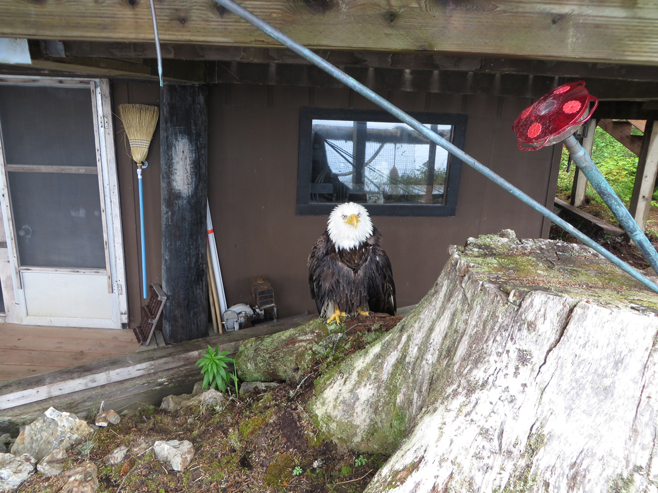When Bernie and Marion Simon arrived at their Kasitsna Bay cabin on June 19, they were greeted by a bald eagle that appeared to be suffering from a wing injury.
“The poor guy was hungry and so cold and wet,” said Marion Simon. “He couldn’t hop around. He kept stepping on his wing.”
The Simons took herring out of their freezer and cut it up to feed the bird.
“He just about ate them right out of our hand,” said Simon.
The couple attempted to enlist the help of several agencies, but some said they had no resources to help across the bay.
Finally, the Simons contacted Joel Vos, a U.S. Fish and Wildlife Service refuge clerk, who contacted Jason Sodergren, president of Kachemak Bay Birders in Homer; the Bird Treatment and Learning Center in Anchorage; and Mako’s Water Taxi.
“I’ve worked with raptors before a little bit, doing some environmental education work and I’m working with (USFWS) staff to come up with a way to respond for eagle rescues and dead eagle recovery,” said Vos.
In addition to running an owl-banding project in Homer, Sodergren also has done some volunteer work with USFWS and the Bird TLC.
“We went over there with basically a large dog kennel, blankets, a landing net and got the eagle,” said Sodergren.
The bird was transported to Anchorage aboard Ravn Alaska, formerly Era Alaska, who has “been nice enough historically to donate flights for injured birds,” said Sodergren.
According to a spokesperson at Bird TLC on Tuesday, the eagle was eating well and was being X-rayed to determine the extent of its injuries.
“What was so sad is that we have the tallest tree by our cabin and the eagles sit up there and the other day there was an eagle sitting up there talking. It flew around, sat again and talked some more. I wonder if it was its (the injured eagle’s) mate,” said Simon. “I sure hope they’re going to be able to put him back together.”
It is important to note not all eagles appearing to be injured are in need of help.
“People make assumptions when they see them, especially around the fish cleaning bins, when they approach an eagle and it won’t fly,” said Vos. “What oftentimes is going on is that they’re too fat to fly. They’ve gorged themselves on so much food that they have to digest it before they can get airborne.”
Vos recommended being patient, stepping back and observing the bird.
“If it hasn’t moved in a good number of hours from that location, call,” he said.
“The number one reason people should be calling us is if they’ve observed an injury. The bird was struck by a car or electrocuted by a power line. Something like that. Those are cases to call straight away.”
Development of a response network is underway.
In the meantime, Vos said to report injured or dead eagles by calling the refuge at 235-6546 during business hours. After hours, callers should leave a message.
For more information or to learn about birding in general, visit kachemakbaybirders.org.


